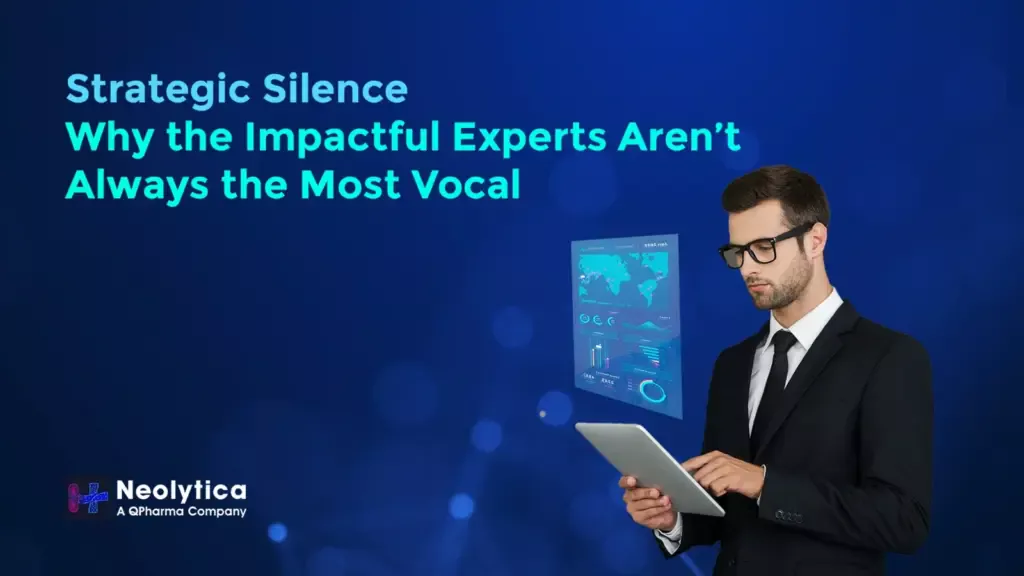Volume isn’t the same as influence. Some Key External Experts shape clinical thinking without posting daily threads or dominating conference panels. They publish pivotal guidelines, lead multi‐center studies, advise payer committees, and move their peers through quiet credibility. Leadership literature calls this “strategic silence,” the disciplined choice to speak less, listen more, and intervene only when it matters. Done well, silence signals judgment and creates space for better decisions.
If your KEE strategy overweights the loudest digital voices, you risk missing the clinicians who actually change practice. Here’s how to find, understand, and engage those quieter drivers of adoption.
Rethink “influence”: beyond follower counts
Digital activity is one signal, not the signal. A robust expert picture blends:
- Scientific authority: guideline authorship, trial leadership, high-impact publications, and recurring roles at major congresses.
- Network position: who unites peers across institutions and subspecialties, even if they post infrequently online.
- Audience quality: reach into clinician communities that make purchase, formulary, or protocol decisions.
Healthcare teams that treat “posts per week” as a proxy for impact risk chasing noise. Strategic silence can be a strength: leaders who speak selectively often carry higher trust when they do speak.
How to surface high-impact but low-volume experts
- Map expert networks, not just posting history.
Instead of focusing on how often or when someone posts, track who they repeatedly work with (co-authored papers, multi-center trials, guideline or congress committees) and who gets invited across institutions or specialties. These connectors often shape practice even if they’re not very active online. - Weight scientific signals.
Combine publication quality, citation velocity, and session chair roles with digital signals to rank practical influence within a therapy area. KOL/KEE mapping frameworks recommend this blended approach. - Differentiate DOLs from KEEs.
Digital Opinion Leaders (DOLs) can accelerate awareness, but clinicians who rarely post may still steer protocols. Treat DOL engagement as complementary to KEE engagement, not a substitute. - Assess engagement quality, not just reach.
Prioritize experts whose limited posts trigger peer debate, article downloads, or field team inquiries. This “resonance” often predicts behavior change better than impressions alone. - Focus on medically relevant topics.
Anchor your list to the therapy areas and subtopics that matter to your teams; tag experts by specialty, guideline role, study method, and geography so outreach aligns with current clinical priorities.
When silence is a signal (and how to read it)
Strategic silence is not absence; it’s intent. In leadership contexts, purposeful pauses can build credibility, prevent missteps, and focus attention when a statement finally lands. The same pattern appears with KEEs who publish sparingly, speak after data matures, and avoid speculative commentary, behavior that can increase trust among peers.
Key events to monitor:
- Sudden drop in commentary from a usually active expert near a data milestone (possible embargo/advisory activity).
- Private-channel activity (workshops, closed boards) is rising while public posting falls; the conversation may have moved behind the scenes.
- Peer amplification: others cite the expert’s slide decks or remarks even when the expert isn’t posting.
- Sentiment shifts by topic: tone moving from supportive to neutral or skeptical (or vice versa) around abstracts, safety updates, or guideline changes; note inflection points and link them to downstream behaviors (field team requests, demo interest).
Engagement playbook for quieter KEEs
- Lead with data, not volume. Share de-identified real-world evidence, detailed methods, and slide-level clarity. Quiet experts lean in when the evidence is tight and easy to review.
- Choose small, focused settings. Invite them to advisory boards, case-based roundtables, or brief embargoed previews rather than large public webinars.
- Offer authorship-adjacent opportunities. Ask for their input on methods reviews, real-world analyses, or consensus statements. These contribute to the field more than generic social campaigns.
- Reach out at the right moments. Tie your contact to key milestones like abstract releases, registry updates, or guideline revisions, times when thoughtful voices are most active.
- Track real outcomes. Record what changes after the interaction: protocol tweaks, trial referrals, field team follow-ups. Prioritize these over likes, impressions, or generic reach.
How Neolytica helps you notice the “quiet” influence
- Multisource aggregation: We pull publications, congress roles, advisory boards, closed professional forums, and curated social activityfrom digital platforms (over 100,000 sources) into a single view.
- Network analytics: Identify key expert networks. Our network maps show who connects peers across sites and specialties.
- Measure audience quality: Score audiences by clinician density and engagement depth, not just size.
- Adaptive alerting: Alerts flag behavior shifts like an expert posting less publicly but joining key committees, so medical affairs can adjust outreach fast.
In conclusion, the experts who drive change aren’t always the ones who post most. Strategic silence often signals the kind of authority that changes practice. By building an Expert Universe that connects influence, behavior, and reach, teams can engage the right KEEs at the right moments and translate expertise into adoption, without being distracted by the loudest voices.

